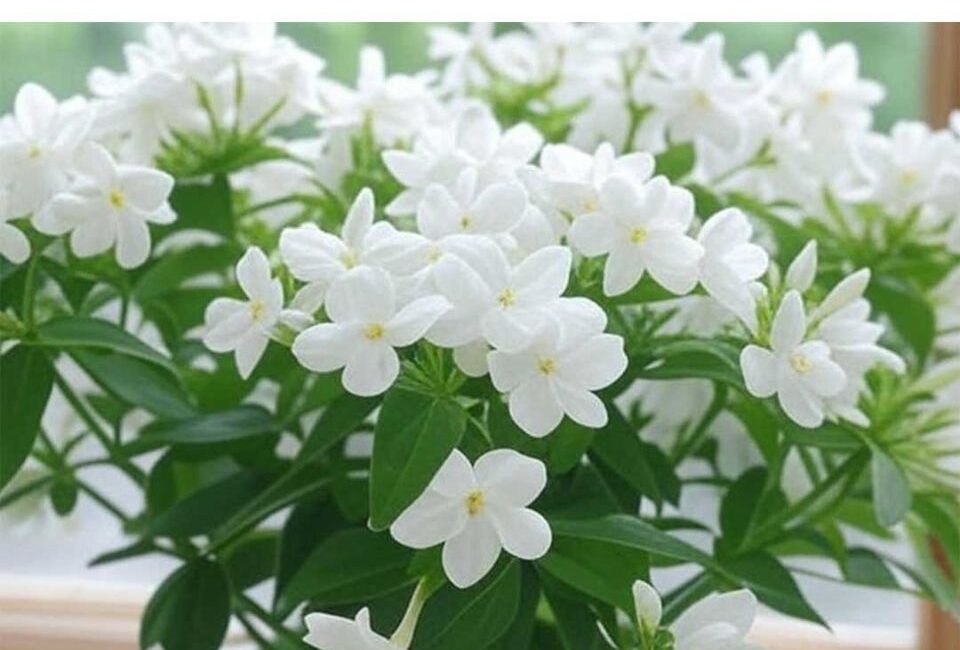Having plants in your home is a wonderful way to bring the outdoors inside, and they do so much more than just add a pop of greenery. Many houseplants also have incredible fragrances that can make your home smell fresh, inviting, and cozy. Whether you want to create a calming atmosphere, mask unpleasant odors, or simply enjoy a beautiful scent, there are many houseplants that can elevate the olfactory experience in your living space. In this article, we will explore 11 of the best-smelling houseplants that will make your home smell amazing!
1. Jasmine (Jasminum spp.)
Jasmine is known for its sweet, intoxicating fragrance, often associated with romance and relaxation. This climbing or trailing plant produces fragrant white or yellow flowers that bloom in the evening, releasing their scent into the air. Jasmine is particularly great for placing near windows or in rooms where you spend time in the evening, as its fragrance is most potent at night.
Key Benefits:
- Highly fragrant, especially at night
- Produces small, white or yellow flowers
- Promotes relaxation and improves sleep quality
Care Tips:
- Jasmine plants thrive in bright, indirect light
- Water regularly, but allow the soil to dry out slightly between waterings
- Prune back after flowering to maintain shape
2. Lavender (Lavandula spp.)
Lavender is one of the most popular and well-known aromatic plants. Its calming, floral scent is often used in aromatherapy for its relaxing and stress-relieving properties. Lavender’s purple flowers are not only visually appealing but also emit a strong fragrance that can fill a room. It’s perfect for bedrooms, bathrooms, or any space where you want to create a tranquil atmosphere.
Key Benefits:
- Known for its relaxing and sleep-inducing qualities
- Beautiful purple flowers
- Natural insect repellent
Care Tips:
- Lavender prefers full sun, so place it in a sunny spot
- Water sparingly; lavender is drought-tolerant
- Ensure the soil is well-draining to prevent root rot
3. Gardenia (Gardenia jasminoides)
Gardenias are beloved for their strong, sweet fragrance. The creamy white blooms release an intense, intoxicating scent that can make any room feel fresh and elegant. While gardenias can be a bit finicky about their growing conditions, their fragrance makes the effort well worth it. They thrive in high humidity, so placing them in bathrooms or kitchens can enhance their scent.
Key Benefits:
- Extremely fragrant, with creamy white flowers
- Makes an elegant addition to any room
- Can improve mood and mental clarity
Care Tips:
- Gardenias need bright, indirect light
- Keep the soil consistently moist, but not waterlogged
- Ensure the humidity level is high for optimal growth
4. Eucalyptus (Eucalyptus spp.)
Eucalyptus is known for its refreshing, minty scent that is both invigorating and soothing. The aromatic oils found in the leaves of the eucalyptus plant are often used in medicinal products, and the fresh scent can help clear the sinuses and promote relaxation. Eucalyptus plants are ideal for kitchens or bathrooms, where their fresh scent can keep the air feeling clean and crisp.
Key Benefits:
- Refreshing, minty aroma that can clear sinuses
- Great for promoting relaxation and mental clarity
- Can act as a natural disinfectant
Care Tips:
- Eucalyptus plants prefer bright, direct sunlight
- Water moderately, allowing the soil to dry out slightly between waterings
- Prune regularly to maintain shape
5. Scented Geraniums (Pelargonium spp.)
Scented geraniums are unique because they offer a wide range of fragrances, from rose to lemon to mint. These fragrant herbs are often used in perfumes and aromatherapy, and they make wonderful houseplants. Their leaves release their scent when touched, and the scent lingers in the air, adding a pleasant fragrance to any room.
Key Benefits:
- Offers a variety of scents, including rose, lemon, mint, and more
- Easy to grow and care for
- Leaves release scent when touched, which can be a fun sensory experience
Care Tips:
- Scented geraniums prefer bright, indirect sunlight
- Water when the top inch of soil feels dry
- Prune regularly to encourage healthy growth
6. Mint (Mentha spp.)
Mint is a wonderfully fragrant herb that can be grown indoors in a pot or container. The leaves of mint plants release their fresh, cooling scent when brushed against, and the smell can fill the room with a refreshing aroma. Mint can also be used in cooking, making it a versatile plant for your kitchen windowsill.
Key Benefits:
- Invigorating, fresh scent that can help with focus and concentration
- Can be used in cooking and herbal teas
- Grows quickly and easily indoors
Care Tips:
- Mint prefers bright, indirect sunlight
- Keep the soil moist, but ensure good drainage
- Regularly pinch back the plant to prevent it from becoming too leggy
7. Tuberose (Polianthes tuberosa)
Tuberose is a fragrant flowering plant that produces highly aromatic white blooms, often used in perfumes and scented oils. The flowers have a sweet, tropical fragrance that fills the room and can linger for hours. Tuberoses are perfect for creating a luxurious, exotic ambiance in your home.
Key Benefits:
- Exotic, sweet floral fragrance
- Long-lasting scent that lingers in the air
- Makes a stunning addition to indoor gardens
Care Tips:
- Tuberose prefers bright, indirect sunlight
- Water regularly, ensuring the soil is well-drained
- Deadhead flowers to promote new blooms
8. Orange Jasmine (Murraya paniculata)
Orange jasmine is a fragrant shrub that produces clusters of small, white flowers that have a citrusy, sweet aroma. The fragrance is often compared to that of orange blossoms, making it a great choice for adding a fresh, zesty scent to your home. This plant is perfect for sunny spaces or areas where you want a light, citrusy fragrance.
Key Benefits:
- Sweet, citrusy fragrance that resembles orange blossoms
- Easy to care for and maintain
- Produces attractive white flowers year-round
Care Tips:
- Orange jasmine prefers full sun to partial shade
- Water regularly, ensuring the soil doesn’t dry out completely
- Prune occasionally to maintain shape and promote new growth
9. Lemon Balm (Melissa officinalis)
Lemon balm is a fragrant herb that belongs to the mint family. Its leaves have a distinct lemon scent, and when crushed or rubbed, they release their fresh, citrusy aroma into the air. Lemon balm is not only great for adding fragrance to your home, but it also has calming properties, making it perfect for bedrooms or living areas where relaxation is key.
Key Benefits:
- Fresh, citrusy scent that is uplifting and calming
- Leaves can be used in herbal teas
- Great for relieving stress and anxiety
Care Tips:
- Lemon balm prefers bright, indirect sunlight
- Water regularly, keeping the soil moist but not soggy
- Prune the plant to prevent it from becoming too leggy
10. Hoya (Hoya spp.)
Also known as wax plants, hoyas are known for their unique, fragrant flowers. When they bloom, they release a sweet, honey-like fragrance that fills the room. Hoyas are ideal for hanging baskets or as trailing plants and can be placed in bright, indirect light to encourage blooming.
Key Benefits:
- Sweet, honey-like fragrance when in bloom
- Low-maintenance and easy to grow
- Attractive waxy flowers that can add visual interest
Care Tips:
- Hoya plants prefer bright, indirect sunlight
- Water sparingly; allow the soil to dry out between waterings
- Repot every couple of years to encourage healthy growth
11. Stephanotis (Stephanotis floribunda)
Stephanotis, also known as Madagascar Jasmine, produces clusters of small, white, tubular flowers with a wonderfully sweet and fragrant scent. These flowers are often used in bridal bouquets due to their delightful aroma. Stephanotis makes an excellent houseplant for creating a fragrant, tropical vibe in your home.
Key Benefits:
- Highly fragrant, sweet-scented white flowers
- Tropical look that adds elegance to your home
- Often used in floral arrangements and bouquets
Care Tips:
- Stephanotis prefers bright, indirect sunlight
- Keep the soil moist but well-drained
- Prune back after flowering to maintain shape
Conclusion
Incorporating fragrant houseplants into your home is a natural and beautiful way to enhance your indoor environment. Whether you prefer the calming scent of lavender, the refreshing fragrance of eucalyptus, or the tropical aroma of tuberose, these 11 plants will make your home smell amazing. By choosing the right plants for your space and following the care tips, you can enjoy a fresh, pleasant-smelling home year-round, without relying on artificial air fresheners. Embrace the natural beauty of houseplants and let their fragrances transform your living space into a fragrant oasis!




